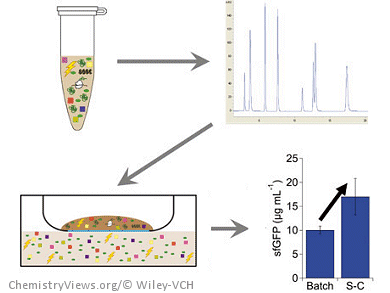Protein production is a highly active area of research spanning applications from industrial enzyme synthesis to the production of next generation therapeutics. Whereas cell-free protein synthesis (CFPS) was originally mainly used as a research tool, it now has emerged as a new strategy for protein production. Yeast CFPS is often used to express proteins that are difficult to be actively expressed in other organisms, but this method currently suffers from low product yields.
Michael Jewett, Northwestern University, Evanston, USA, and colleagues studied factors that cause the unwanted termination of yeast CFPS reactions. They used high-performance liquid chromatography (HPLC) and chemical assays to characterize the substrate and by-product concentrations in the reaction batch. Creatine phosphate, a secondary energy substrate, and nucleoside triphosphates were rapidly degraded during batch CFPS, causing termination of the protein synthesis. As a toxic by-product, inorganic phosphate accumulated. Also, aspartic acid was rapidly consumed. By adopting a semi-continuous reaction format, where passive diffusion enables substrate replenishment and by-product removal, they achieved a 70 % increase with a model protein compared to the batch system.
- Substrate replenishment and byproduct removal improve yeast cell-free protein synthesis,
Jennifer A. Schoborg, C. Eric Hodgman, Mark J. Anderson, Michael C. Jewett,
Biotechnol. J. 2014.
DOI: 10.1002/biot.201300383



